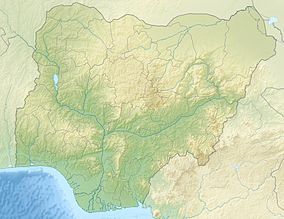Gashaka Gumti National Park
| Gashaka Gumti National Park | |
|---|---|
 | |
| Location | |
| Coordinates | 07°21′00″N 11°31′12″E / 7.35000°N 11.52000°E |
| Area | 6402 km2 |
| Established | 1991 |
Gashaka-Gumti National Park (GGNP) is a national park in Nigeria, It was gazetted from two game reserves in 1991 and is Nigeria’s largest national park. It is located in the eastern provinces of Taraba and Adamawa to the border with Cameroon. The total area covers about 6,402 km2, much of the northern GGNP is savannah grassland, while the southern GGNP sector of the park has a rugged terrain characterized by very mountainous, steep slopes as well as deep valleys and gorges, and is home to montane forests. Altitude ranges from ranging from about 457 metres (1,499 ft) in the northern flatter corner of the park, up to 2,419 metres (7,936 ft) at Chappal Waddi, Nigeria’s highest mountain in the park's southern sections. It is an important water catchment area for the Benue River. There is abundant river flow even during the markedly dry season.[1] Enclaves for local Fulani pastoralists exist within the park boundary that allow for farming and grazing.[2]
Fauna
The fauna of the national park is very diverse. 103 species of mammals have been recorded at censuses. Species include yellow-backed duiker, African golden cat (Profelis aurata), The African buffalo, the largest population in Nigeria of chimpanzee (Pan troglodytes) is found within the boundaries of the national park. To protect the animals and the ecosystem, the Gashaka Primate Project was launched. Living in the national park are also the African elephant (Loxodonta africana), the klipspringer (Oreotragus oreotragus), the West African wild dog (Lycaon pictus manguensis), the hartebeest (Alcelaphus buselaphus), the world's largest antelope, the giant eland (Taurotragus Derbianus), the roan antelope (Hippotragus equinus), the kob antelope (Kobus kob), the oribi (Ourebia ourebi), and the rare Adamawa mountain reedbuck (Redunca fulvorufula) in larger stocks[2]. There are also Chimpanzees (Pantrolodytes vellerous), Golden cat (Fellies Aurata) and giant Forest Hog (Hylochoreus meinertzageni). Predator animals sch as Lion (Panthera Leo), Leopard (Panthera Pardus) and Wild dog can also be found in the park.[3]
The avian fauna is very rich and diverse, there are stocks are up 1 million birds estimated. The park is officially labelled as one of Africa's "Important Bird Areas" - and with more than 500 species found, and visiting bird watching enthusiasts are constantly adding new species to the list. The red faced lovebird is only found here and in the Central African Republic's Bamingui-Bangoran National Park and Biosphere Reserve .[4]
Flora
In November 2002 an isolated population of the red sunbird bush, an ornate species of the acanthus family,[5] was discovered in the 8 km2 Leinde Fadale forest in the uplands adjacent to the park.[6] The species occurs here at 1,600 to 1,670 m.a.s.l., and some 1,200 km from the nearest populations in the Afromontane archipelago. It has been suggested that the park boundary should be extended to protect the forest.[6] There are various tree species in the park with different tree species growing in different sectors of the park. At Northen Gumti sector, there are tall trees such as Acacia spp, Afzelia Africana, Khaya Seneglensis, Daniella Oliverii, Isober linadoka and Vitellaria paradoxa. At the Gashaka, which is the Southern part of the park, vegetation is closely related to the Southern Guinea Savanna. The dominant tree species in the area include Triplochyton schleroxylon and Aubrvillea kerstingii Africana, Symphonia globulifera and Mallettia spp.[3]
Human animal Conflict in Gashaka Gumti National Park
Human animal conflict is rampact in all settlements where man and animals share the same environment or where conservation areas share boundaries with human settlement[3]. In the Gashaka Gumti Park, the communities in the environment experience the same conflict. There are about 25 communitiesis residing in the immediate sorroundinging of the park.[7]
References
- ^ "APESMAPPER". Archived from the original on 2009-08-09. Retrieved 2010-07-13.
- ^ a b Chapman, Hazel M.; Olson, Steven M.; Trumm, David (1 August 2004). "An assessment of changes in the montane forests of Taraba State, Nigeria, over the past 30 years". Oryx. 38 (3). doi:10.1017/S0030605304000511.
- ^ a b c Dishan, E. E.; Agishi, R.; Akosim, C. (2010). "Women's Involvement in Non Timber Forest Products Utilization in Support Zones of Gashaka Gumti National Park". Journal of Research in Forestry, Wildlife and Environment. 2 (1): 73–84. ISSN 2141-1778.
- ^ Forshaw, Joseph M.; Knight, Frank (27 September 2010). Parrots of the World. Princeton University Press. pp. 154–. ISBN 978-0-691-14285-2. Retrieved 23 April 2011.
- ^ Baden, Claus (April 1981). "The genus Macrorungia (Acanthaceae), a taxonomic revision". Nordic Journal of Botany. 1 (2): 143–153. doi:10.1111/j.1756-1051.1981.tb00687.x.
- ^ a b Darbyshire, Iain; Vollesen, Kaj; Chapman, Hazel M. (23 January 2009). "A remarkable range disjunction recorded in Metarungia pubinervia (Acanthaceae)". Kew Bulletin. 63 (4): 613–615. doi:10.1007/s12225-008-9073-3. S2CID 40176831.
- ^ Eniang (2011). "Assessment of Human Wildlife conflicts in Filinga Range of Gashaka Gumti National Park". PAT. 7 (1): 15–35.

